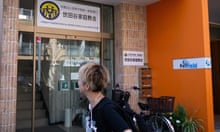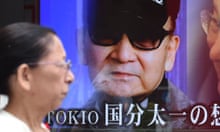Vosot Ikeida traces the start of his life of isolation to a time when most people are beginning to spread their wings.
Ikeida (not his real name) had moved from his family home in Nagoya, central Japan, to study at a prestigious university in Tokyo when he began to feel alienated from his peers.
“The campus was full of smart boys who were aiming to become businessmen, politicians and lawyers,” Ikeida, 60, told the Guardian via email. “I couldn’t find anyone who shared my views about the world. I quickly realised that I was in the wrong place … that I wasn’t suited to it. I was a stranger.”
He tried to break free from his isolation by travelling overseas, only to spend most of his time holed up in hotel rooms, unable to contemplate a simple sightseeing trip. “I read, wrote, drank and slept. I didn’t like travelling after all. I was a hikikomori overseas.”
Japan’s health ministry defines a hikikomori – a term coined in the late 1990s by the journalist Tamaki Saito – as someone who has remained isolated at home for at least six months, shunning school or work and rarely interacting with people outside their immediate family.
But in one sense, Ikeida is far from alone. Almost 1.5 million people of working age (or one in 50 Japanese) – are living as hikikomori, a combination of the Japanese verbs to “pull back” and “seclude oneself” – with about a fifth of cases attributed to the pressures unleashed by the Covid-19 pandemic.
In a cabinet office survey released last month, large numbers of hikikomori said they had suffered severe social withdrawal due to relationship issues or after losing or leaving their jobs. But a significant proportion – 20.6% – said the change had been triggered by the pandemic.
While Japan did not enforce UK-style lockdowns to help contain the spread of the virus, it asked people to avoid unnecessary outings, while some employers and universities turned to remote working and learning.
The technological tools that enabled people around to function during the pandemic have also contributed to a growing sense of isolation. “The pandemic made us realise that teleworking, remote learning and home deliveries are very useful,” Ikeida said. “Many of these lifestyle changes remained even after Covid-19 passed.”
Once regarded as a condition that almost exclusively affected socially maladjusted young men confined to their bedrooms and hooked on video games, manga and anime, prolonged social disconnection now affects a much wider demographic.
While an estimated 60% of the people counted in official statistics are men, more women are coming forward to describe their post-pandemic experience of isolation.
“I sometimes think about taking a walk in the morning, but then my muscles become stiff … I can’t get my body to go outside,” Michi, a 45-year-old Tokyo woman who lost her job during the pandemic, said in a recent report by the public broadcaster NHK.
Concern over the recent increase in the number of hikikomori has spurred several initiatives to encourage people to break free of their isolation, if only temporarily or, in some cases, virtually.
The Tokyo ward of Edogawa, home to an estimated 9,000 hikikomori, will start holding metaverse socialising events next month to give people the opportunity to meet via their avatars. Kyoto prefecture organises virtual meet-ups twice a month, with participants ranging from teenagers to people in their 40s.
Ikeida regularly holds online and in-person events which, he says, give people with similar problems the chance to “exchange emotions, information and courage”, as well as sessions for parents and children who have lost the ability to communicate at home.
But Ikeida says he has not spent his 30 years as a recluse in a darkened room devouring anime – he is not a fan – and stresses many people who classify themselves as hikikomori do occasionally venture out.
After passing several job interviews, the young graduate’s symptoms worsened. He struggled to move, spending days lying in his futon. “I quit my company before I had even started working there. This was the start of my hikikomori career.”
He later travelled around India, the Middle East and Africa for 10 years, before returning to Japan to make a failed attempt to restart his life.
“I can’t go out as often as ‘normal’ people do. I go out on average only once every three or four days. I sleep 14 hours a day. I have absolutely no contact with my neighbours or relatives. I correspond with lots of people online, without stepping out of my room. That’s the best I can do for now. I am still a hikikomori.”









